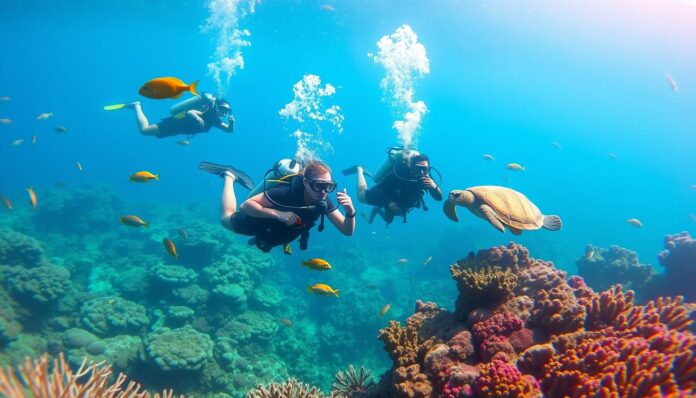| Best Time to Travel | December to May |
| What to Expect | Warm water, clear visibility, diverse marine life |
| Diving Conditions | Year-round, but best from December to May |
| Marine Life | Reef sharks, turtles, rays, fish, shipwrecks |
Are you ready to explore a Caribbean diving paradise? Scuba diving in Trinidad and Tobago offers an underwater world that promises breathtaking experiences. It’s a place beyond your wildest dreams.
This dual-island nation sits at the southern tip of the Caribbean chain. It presents divers with an extraordinary marine ecosystem. Tobago, the smaller sister island, is a premier destination for scuba diving enthusiasts. It offers vibrant coral reefs and diverse marine life.
With water temperatures consistently averaging around 85°F, Trinidad and Tobago create the perfect underwater playground. The northern regions of Tobago boast remarkable coral heads. They also have an incredible array of marine biodiversity that will captivate both novice and experienced divers.
Key Takeaways – Scuba Diving in Trinidad and Tobago
- Unique Caribbean diving destination with exceptional marine ecosystems
- Consistent warm water temperatures year-round
- Diverse marine life and stunning coral reefs
- Suitable for divers of all skill levels
- Located outside the hurricane belt, ensuring stable diving conditions
- Excellent visibility during optimal diving seasons
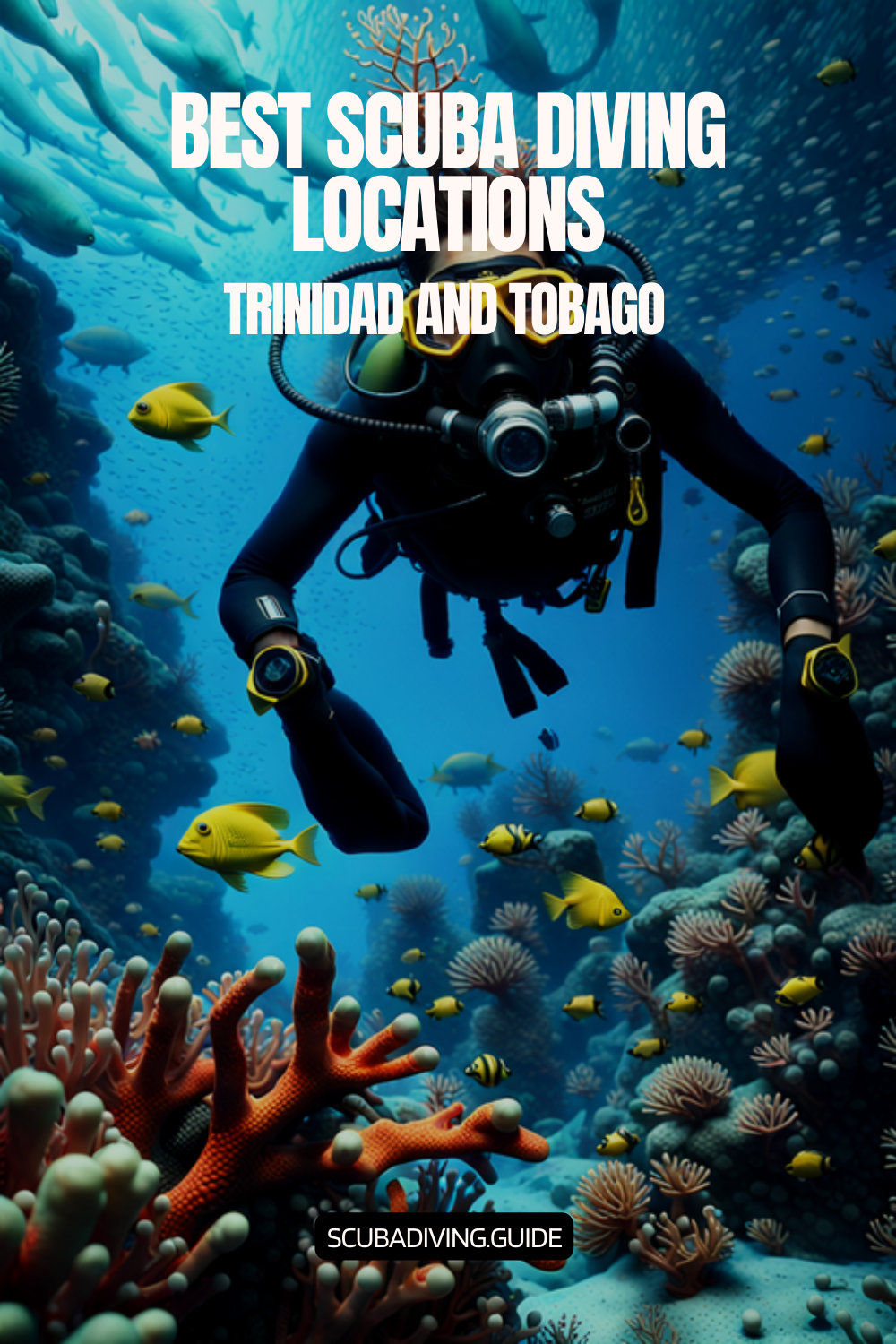
Why Choose Trinidad and Tobago for Scuba Diving?
Divers looking for an amazing underwater journey will love Trinidad and Tobago. These Caribbean islands have a unique marine world that draws divers from everywhere.
The islands are a top diving spot with special features. They stand out from other Caribbean places:
- Exceptional marine biodiversity
- Year-round diving conditions
- Pristine underwater landscapes
- Unique cultural experiences
Stunning Marine Biodiversity
Tobago has some of the highest marine life in the Caribbean. Divers see vibrant ecosystems full of different species. Wreck diving fans will love sites like The Maverick, with its Indo-Pacific coral and fish.
“The underwater world of Trinidad and Tobago is a living museum of marine wonders.” – Local Marine Biologist
Ideal Diving Conditions
Water is always between 80-85°F, making diving comfy. Underwater photography is stunning with up to 130 feet visibility.
| Diving Season | Water Temperature | Visibility |
|---|---|---|
| Dry Season (Jan-May) | 82-85°F | Up to 130 feet |
| Wet Season (Jun-Dec) | 77-83°F | 30-80 feet |
Vibrant Local Culture and Hospitality
Trinidad and Tobago offer more than just diving. They have warm Caribbean hospitality. Divers can dive into local culture and enjoy real experiences.
Best Scuba Diving Spots in Trinidad
Trinidad is a paradise for scuba diving, with its rich marine life and stunning underwater scenes. The island’s waters are perfect for drift diving, revealing vibrant ecosystems and breathtaking landscapes.
Trinidad has many diving spots for all levels of divers. With about 40 dive sites nearby, explorers can dive into a world full of marine life.
Speyside Marine Park
Speyside Marine Park is a top spot for diving, giving a close look at Trinidad’s marine world. The park is known for:
- Pristine coral formations
- Exceptional underwater visibility
- Diverse marine life populations
Drift diving fans will love the area’s strong currents. These currents support a wide range of marine species. The park’s rich waters attract many fish, making the underwater world vibrant.
Buccoo Reef
Buccoo Reef is a marine sanctuary that offers a unique diving experience. It’s famous for:
- Extensive coral gardens
- Breeding grounds for multiple fish species
- Clear waters ideal for marine exploration
“Diving at Buccoo Reef is like entering a living, breathing underwater museum of marine biodiversity.” – Local Diving Expert
The Nylon Pool
The Nylon Pool is a special diving spot, with a shallow sandy area in the sea. It’s a chance to see a unique marine environment with clear waters and interesting geological features.
Trinidad’s diving spots are home to an amazing variety of marine life. It’s a favorite place for those who love diving and want to see incredible underwater sights.
Top Scuba Diving Locations in Tobago
Tobago has over 50 dive sites, making it a paradise for scuba lovers. The island’s marine world offers a mix of adventure and eco-tourism.
More than 300 species of marine life call Tobago’s waters home. Each dive site is unique, promising unforgettable underwater adventures.
Coral Gardens
Coral Gardens is a top dive spot. It features stunning coral and a wide variety of marine life. Divers can explore coral ecosystems and see many marine species.
- Rich coral formations
- Diverse marine life
- Suitable for intermediate divers
The Maverick Wreck
The MV Maverick, a 107-metre ex-Trinidad-Tobago car ferry, is a famous wreck dive. It’s a thriving artificial reef, full of marine life.
| Wreck Details | Specifications |
|---|---|
| Length | 107 meters |
| Depth Range | 30-36 feet |
| Marine Life | Diverse fish species |
Captain Keiths Wreck
Captain Keiths Wreck is another great dive site. The sunken ship is home to many marine creatures. It offers a fascinating underwater world for divers to explore.
“Diving in Tobago is not just an adventure, it’s an opportunity to connect with marine ecosystems responsibly.” – Local Dive Instructor
Tobago’s dive sites show the island’s dedication to eco-tourism. They offer amazing underwater experiences while protecting marine life. Divers are asked to respect the ocean and dive sustainably.
Scuba Diving Certification Courses Available
Dive certification is key for exploring Tobago Cays and Trinidad’s underwater wonders. It’s for both beginners and seasoned divers. This Caribbean paradise offers many certification options.
There are various internationally recognized programs for diving. Local dive centers provide flexible learning for all ages and skill levels.
PADI Certification Options
The Professional Association of Diving Instructors (PADI) offers several certification paths:
- Open Water Diver Course: Allows diving to 18 metres (60 feet)
- Junior Open Water Diver: For ages 10-14
- Advanced Open Water Diver: Enhances diving skills
Course Details and Requirements
| Course Type | Duration | Age Requirement | Cost (USD) |
|---|---|---|---|
| Open Water Diver | 4-5 days | 10+ years | $650 |
| Discover Scuba | 2.5 hours | 10+ years | $120-$165 |
| Advanced Course | 2 days | 15+ years | $550 |
Specialty Courses for Experienced Divers
Advanced skills are available through specialty courses in:
- Underwater photography
- Night diving
- Wreck exploration
- Reef conservation
“Certification is your passport to underwater adventure in Tobago Cays.” – Local Dive Instructor
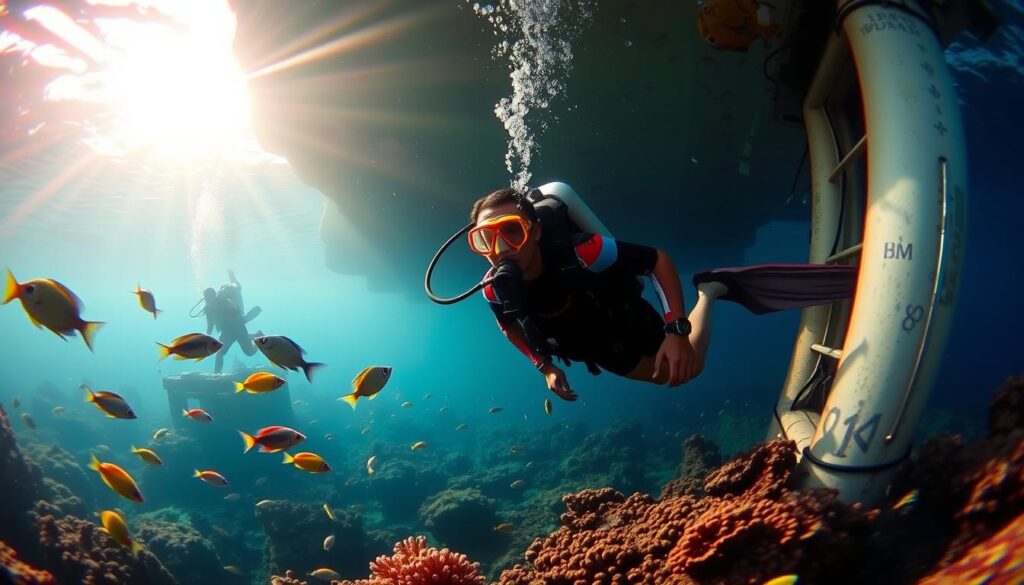
Divers can start their academic part online with PADI E-Learning. This makes preparation easy and flexible. All needed equipment is provided during training, so you don’t have to buy it upfront.
When is the Best Time to Dive?
Scuba diving in Trinidad and Tobago is exciting all year round. The islands offer unique diving experiences in every season. Each season has its own marine life and underwater landscapes.
Seasonal Diving Conditions
Tobago’s diving season is best from December to April. This time offers the best conditions for exploring vibrant coral reefs. The water is warm, between 26°C and 30°C, making it perfect for all divers.
- Dry Season (January to June):
- Peak visibility up to 36 meters
- Clearest water conditions
- Most predictable marine environments
- Wet Season (July to December):
- Decreased visibility (10-15 meters)
- Nutrient-rich waters from Orinoco River
- Potential for unique marine encounters
Marine Life Highlights
Every season in Tobago offers unique marine experiences. The islands are home to over 300 marine species. This creates amazing underwater landscapes for scuba diving.
| Season | Marine Life Highlights |
|---|---|
| Dry Season | Manta rays, hammerhead sharks, diverse reef fish |
| Wet Season | Increased plankton, migrating marine species |
Weather Considerations for Divers
Divers need to be ready for different conditions. The Orinoco River’s currents affect visibility and marine life. Experienced divers enjoy these changing environments.
“Tobago’s waters are a living canvas, changing with each season’s unique marine brushstrokes.” – Local Dive Instructor
Scuba diving in Trinidad and Tobago is unforgettable, no matter the season. You’ll see stunning coral reefs.
Essential Gear for Scuba Diving
Getting ready for an underwater adventure in Trinidad and Tobago means picking the right gear. The right equipment can make your dive better and keep you safe while taking photos underwater.
Choosing the Right Wet Suit
Water in Trinidad and Tobago is warm, between 25°C and 28°C. Choosing the right wetsuit is key. Divers should look for:
- 3mm wetsuit for comfortable tropical diving
- Flexible neoprene material for maximum mobility
- Proper fit to prevent water circulation
Must-Have Equipment for Beginners
Every new scuba diver needs reliable gear. Here’s what’s essential:
- Mask with excellent visibility
- Reliable regulator
- Buoyancy Compensator Device (BCD)
- Dive computer
- Fins for efficient underwater movement
“Invest in quality gear – your safety depends on it.”
Renting vs. Buying Gear
Divers can choose between renting or buying equipment. Renting is great for those diving now and then. Buying is better for those diving often.
| Renting | Buying |
|---|---|
| Lower upfront cost | Personalized equipment |
| No maintenance required | Consistent performance |
| Good for occasional divers | Cost-effective for frequent divers |
When diving in Trinidad and Tobago, the right gear is key. It can turn a good dive into an extraordinary underwater experience.
Safety Tips for Scuba Divers
Exploring Trinidad and Tobago’s underwater world needs more than just excitement. Safety is key for drift diving and meeting marine life. Knowing and using important safety steps can make your dive safe and enjoyable.
Pre-Dive Safety Checks: Your Lifeline Underwater
Before diving into the colorful marine world, do a detailed safety check. These steps help avoid accidents and make diving smooth.
- Inspect all equipment for damage or wear
- Check air tank pressure and functionality
- Verify mask, regulator, and fins are properly secured
- Confirm emergency signaling devices are accessible
Managing Common Diving Risks
Drift diving in Trinidad and Tobago has its own challenges. Knowing the risks is key for safe exploration.
| Risk | Mitigation Strategy |
|---|---|
| Strong Currents | Use drift diving techniques, stay close to guide |
| Marine Life Encounters | Maintain safe distance, avoid touching |
| Decompression Sickness | Ascend slowly, follow depth guidelines |
The Buddy System: Your Underwater Lifeguard
The buddy system is not just a suggestion—it’s essential. Diving with a partner means you have each other’s back and can respond quickly in emergencies.
“Plan your dive, dive your plan” is the golden rule of safe scuba diving.
By sticking to these safety tips, divers can explore Trinidad and Tobago’s stunning marine scenes safely. This way, they can enjoy their dives without worrying about risks.
Understanding Marine Conservation Efforts
Trinidad and Tobago’s marine ecosystems are full of life and diversity. Yet, they face big challenges. The Caribbean has lost half of its coral reefs in 50 years. This makes saving these areas for Eco-Tourism and marine life very important.
Organizations Promoting Conservation
Many groups are working hard to protect the sea:
- Environmental Research Institute Charlotteville (ERIC)
- North East Tobago Man and the Biosphere Reserve
- Local marine conservation nonprofits
*”Protecting our marine ecosystems is not just an environmental imperative, but a commitment to our future.”*
How Divers Can Help Protect Ecosystems
Safe diving is key for saving the sea. Divers in the Tobago Cays can help by:
- Avoiding touching or disturbing marine life
- Using reef-safe sunscreen
- Participating in local conservation programs
- Supporting eco-friendly dive operators
Marine Protected Areas in Trinidad and Tobago
The country has set up important sea zones to keep life in the ocean:
| Protected Area | Size (Hectares) | Key Features |
|---|---|---|
| North East Tobago MPA | 68,384 | Coral reefs, mangroves |
| Buccoo Reef Marine Park | 10,500 | Coral gardens, marine species |
These efforts show the country’s dedication to saving marine life. They do this through careful Eco-Tourism and protection plans.
Local Dive Shops and Operators
Scuba diving in Trinidad and Tobago offers amazing underwater adventures. Professional local dive operators make these experiences unforgettable. Choosing the right dive shop can make your marine adventure even better.
Recommended Dive Shops in Trinidad
Trinidad’s dive scene is perfect for both new and experienced divers. Look for these key things when choosing a dive certification program:
- Professional PADI and SSI instructors
- Modern, well-maintained equipment
- Comprehensive safety protocols
- Local marine ecosystem knowledge
Top Dive Operators in Tobago
Tobago has over 40 amazing dive sites. Operators here offer a wide range of marine experiences. The Crown Point area is known for its incredible diving.
| Location | Dive Site Features | Average Depth |
|---|---|---|
| Crown Point | Macro species, macro marine life | 30-100 feet |
| Speyside | Large brain coral formations | 50-100 feet |
| MV Maverick Wreck | Sunken ferry exploration | 100 feet |
What to Look for in a Dive Operator
When picking a dive operator in Trinidad and Tobago, focus on these important things:
- Dive Certification credentials
- Safety record and insurance
- Equipment quality and maintenance
- Local marine conservation practices
“The right dive operator can turn a simple underwater expedition into an unforgettable journey of discovery.” – Local Diving Expert
With water temperatures from 80-88°F and visibility up to 100 feet, Trinidad and Tobago is a top diving spot. It’s perfect for those who love exploring the underwater world.
Fun Activities Beyond Diving
Trinidad and Tobago has so much more to offer than just Wreck Diving and Coral Reefs. You can dive into a world of adventure, culture, and stunning natural beauty. It’s a place that promises memories you’ll never forget.
Snorkeling Adventures
Snorkeling is a great way to see the marine world without diving deep. The Buccoo Reef Marine Park has clear waters perfect for snorkeling. Here, you can see colorful fish and coral reefs up close.
Exploring Local Culture and Cuisine
Tobago’s culture is as rich as its underwater world. You can taste the local flavors with dishes like:
- Crab and dumplings
- Callaloo
- Fresh seafood specialties
Nature and Wildlife Excursions
The Main Ridge Forest Reserve is a gem for nature lovers. It’s the oldest protected rainforest in the Western Hemisphere. Here, you can:
- Hike through lush forests
- Watch birds
- Go on guided nature tours
“Tobago is a paradise where adventure meets natural beauty at every turn.”
Additional Recreational Activities
Tobago also offers many other fun activities. You can:
- Stand-up paddleboard at Pigeon Point
- Go clear kayaking to see marine life
- Try windsurfing and kite surfing from October to May
No matter if you’re looking for relaxation or adventure, Tobago has it all. It’s the perfect place to add to your diving trip.
Health Considerations for Scuba Divers
When planning a dive trip to Trinidad and Tobago, health and safety are key. Knowing the risks and taking steps to prevent them is vital. This way, you can enjoy the amazing dive sites and marine life safely.
Understanding Decompression Sickness
Decompression sickness, or “the bends,” is a big worry for scuba divers. It happens when divers go up too fast, causing nitrogen bubbles in the blood. To stay safe:
- Always follow proper ascent protocols
- Use a dive computer to track depth and time
- Wait 24 hours after diving before flying
Preparing for Your Dive Trip
Before diving into your underwater adventure, remember these health tips:
- Schedule a thorough medical check-up
- Get PADI certification from a certified instructor
- Make sure your vaccinations are current
“Safety in diving begins with preparation and knowledge” – Professional Diving Expert
Hydration and Nutrition Tips
In tropical places, your health needs extra care. Here’s how to stay safe while exploring:
- Use sunscreen with SPF 15 or higher
- Carry insect repellent with 20% DEET
- Drink plenty of clean water
- Eat regularly to avoid heat-related illnesses
It’s wise to have travel health insurance. Keep a list of local medical facilities and emergency contacts handy. This way, you’re ready for any unexpected issues during your dive trip.
Travel Tips for Visiting Trinidad and Tobago
Planning a dive adventure to Trinidad and Tobago needs careful prep. This tropical spot offers amazing experiences for those who love the sea. You can capture stunning photos underwater or enjoy drift diving.
Getting There: Flights and Transportation
Getting to Trinidad and Tobago is easy with many flight options. Direct flights from major US cities land in Port of Spain. This makes your trip both convenient and thrilling.
- Daily flights available from several US gateways
- Inter-island transportation via scheduled flights
- High-speed ferry services between islands
Accommodation Options for Divers
Choose places to stay that are great for divers. Many resorts offer special services for underwater photography and drift diving.
- Dive resorts near popular marine sites
- Budget-friendly options with diving packages
- Proximity to marine exploration locations
Essential Travel Essentials
Get ready for your tropical trip with these must-haves:
- Underwater camera for capturing marine life
- Appropriate diving gear
- Sun protection
- Necessary medications
“Travel is the only thing you buy that makes you richer” – Anonymous
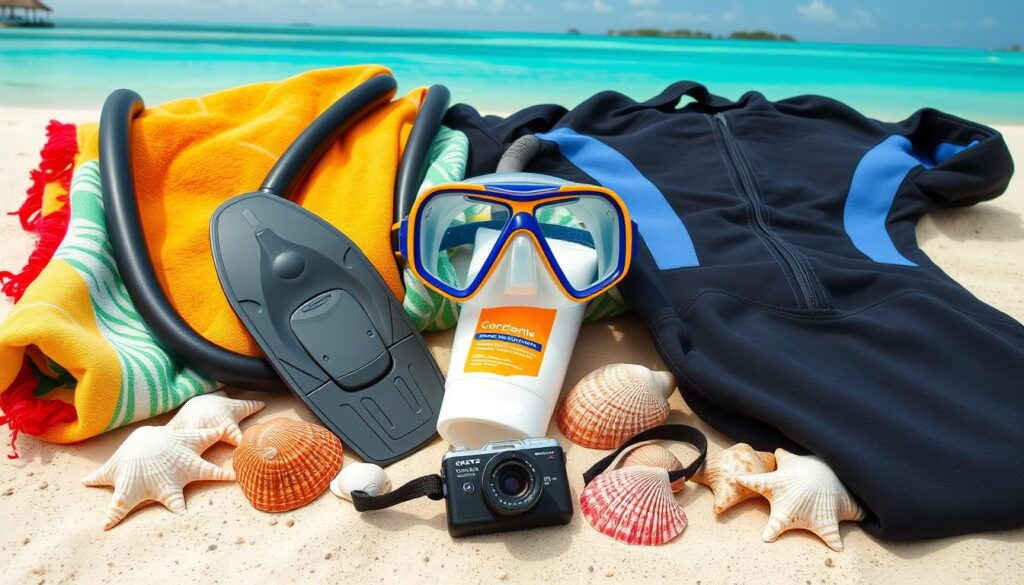
Trinidad’s average temperature is about 31.3°C (85°F), great for underwater fun. The water is between 24°C and 29°C, perfect for diving and photography.
Pro tip: For most countries, you don’t need a visa for stays under 90 days. This makes planning your trip easier for international divers.
Trinidad and Tobago Recommended Diving Itinerary
To make the most of your diving adventure in Trinidad and Tobago, it’s helpful to have a recommended itinerary that allows you to explore the diverse underwater landscapes and iconic dive sites of the islands. This itinerary will guide you through the must-visit locations and provide a well-rounded experience of Trinidad and Tobago’s underwater wonders.
Day 1: Arrival and Orientation
Upon arrival in Trinidad and Tobago, settle into your accommodation and visit the nearest diving center or resort to complete any necessary paperwork and orientation. Familiarize yourself with the local diving regulations, safety procedures, and equipment arrangements. Take this opportunity to discuss your diving preferences and goals with the experts at the diving center to ensure a personalized experience throughout your journey.
Day 2-3: Tobago’s Marine Marvels
Begin your diving adventure in Tobago, known for its exceptional marine biodiversity and captivating dive sites. Start with the iconic Buccoo Reef, Tobago’s most famous reef and a protected marine park. Dive into the crystal-clear waters and immerse yourself in the vibrant coral formations, encountering tropical fish species and exploring the renowned Nylon Pool, a shallow sandy area resembling a natural swimming pool.
Continue exploring Tobago’s dive sites, including Sisters Rocks, where towering volcanic formations and caves offer unique underwater landscapes. Dive among massive boulders and discover hidden marine treasures such as moray eels, nurse sharks, and colorful reef fish.
Day 4-5: Speyside’s Underwater Wonderland
Travel to Speyside, located on the northeastern tip of Tobago, and dive into the enchanting underwater world it has to offer. Dive sites such as the “Japanese Gardens” present breathtaking coral formations, creating a mesmerizing backdrop for encounters with an array of marine life. Enjoy drift dives along vibrant coral walls, exploring the diverse ecosystem and capturing unforgettable memories.
Day 6-7: Trinidad’s Hidden Gems
Head to Trinidad and explore its unique dive sites. Dive at Maverick’s Buoy, known for its impressive drift dives along current-swept walls. Encounter schools of fish, including jacks and snappers, as well as the occasional shark or turtle. Explore the Gasparee Caves, submerged limestone caverns with intriguing rock formations and the possibility of spotting lobsters and seahorses.
Day 8-9: Further Trinidad Adventures
Venture to Carli Bay, a dive site that combines natural and artificial reefs, offering an exciting mix of marine encounters. Swim among vibrant coral gardens, encounter trumpetfish, angelfish, and stingrays, and explore the remains of sunken wrecks that add an extra layer of intrigue.
Continue your Trinidad exploration with a dive at Scottish Wall, an impressive vertical wall adorned with colorful sponges and corals. Keep an eye out for larger marine species like nurse sharks, manta rays, and dolphins that often grace this captivating dive site.
Day 10: Farewell to Trinidad and Tobago
On your last day, reflect on the incredible experiences and memories you’ve created during your diving adventure in Trinidad and Tobago. Take the time to relax, enjoy the beautiful surroundings, and bid farewell to the islands.
This itinerary provides a glimpse into the diverse diving opportunities Trinidad and Tobago have to offer. However, there are numerous other dive sites waiting to be explored. Consult with local diving experts and consider extending your stay to include additional dive sites that match your preferences and interests.
Remember to prioritize safety throughout your itinerary and follow the guidance of experienced dive professionals. Trinidad and Tobago’s underwater world is a treasure trove of marine beauty, and by following a recommended itinerary, you’ll have the opportunity to witness its wonders firsthand.
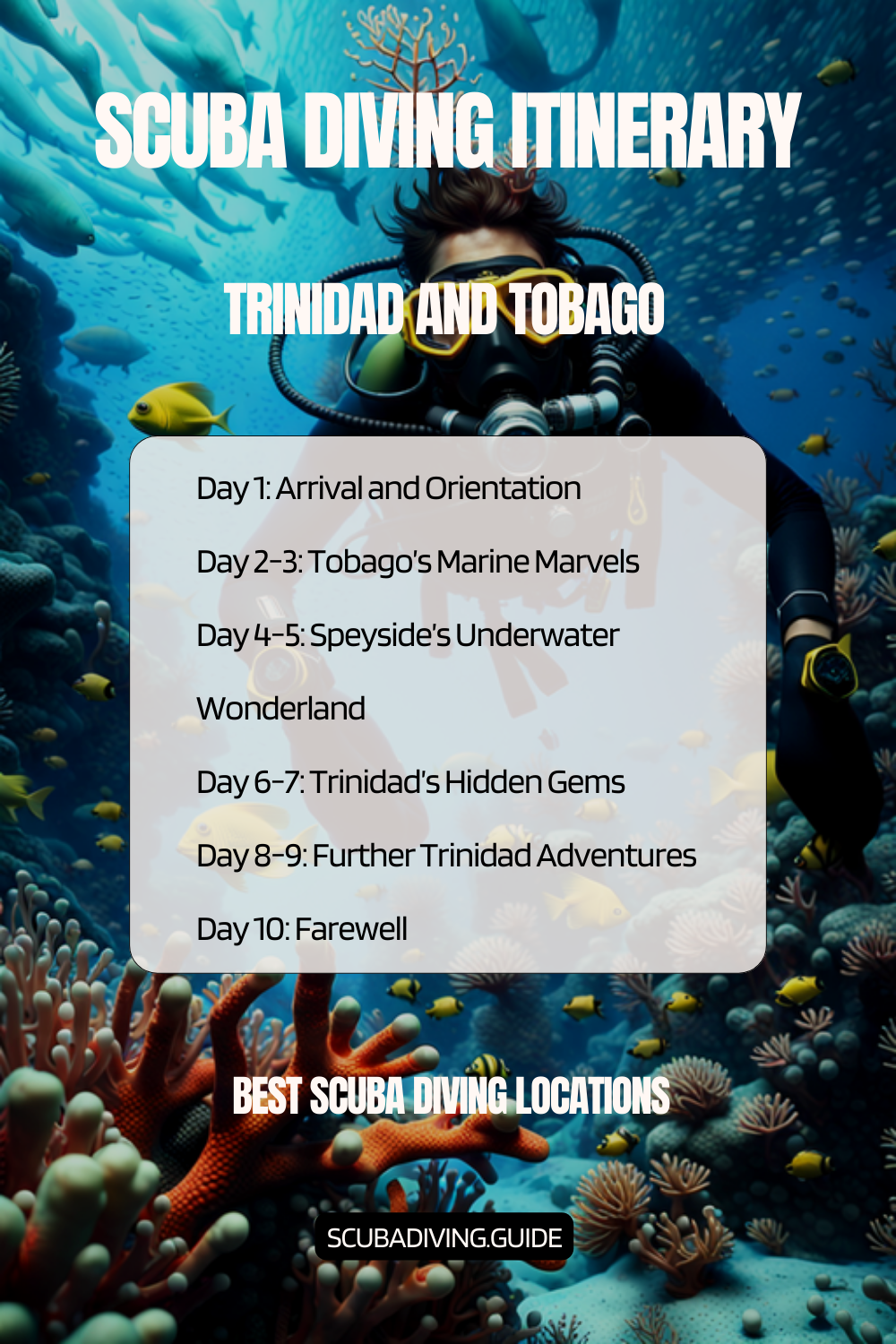
Other Countries to Consider
- Anguilla
- Antigua and Barbuda
- Aruba
- Bahamas
- Barbados
- Bonaire
- British Virgin Islands
- Cayman Islands
- Cuba
- Curaçao
- Dominica
- Dominican Republic
- Grenada
- Guadeloupe Islands
- Haiti
- Jamaica
- Martinique
- Montserrat
- Puerto Rico
- Saba
- Saint Barthélemy
- Saint Kitts & Nevis
- Saint Lucia
- Saint Vincent and the Grenadines
- Sint Eustatius
- Sint Maarten
- The Turks And Caicos Islands
- United States Virgin Islands
Conclusion: Dive into an Unforgettable Experience
Scuba diving in Trinidad and Tobago is a top-notch underwater adventure. The islands are home to some of the Caribbean’s best diving spots. You’ll see unique marine life, including the world’s largest brain coral.
Eco-tourism lovers will find these islands amazing for underwater exploration. Wild Turtle Scuba and other local dive operators offer great chances to see vibrant coral reefs and diverse marine life. Each dive site in Tobago has its own unique underwater world, from exciting drift dives to peaceful coral gardens.
Recap of the Unique Diving Opportunities
Trinidad and Tobago’s underwater world is full of amazing marine encounters. You’ll see detailed coral formations and might even spot rare marine species. The islands have many dive sites, from shallow reefs to fascinating wrecks, for all divers.
Encouraging Sustainable Diving Practices
As responsible travelers, we must care for marine conservation during our dives. By respecting marine environments and supporting local conservation, we help protect these incredible ecosystems. Your commitment to sustainable scuba diving keeps these underwater landscapes beautiful and alive for the future.
FAQ – Scuba Diving in Trinidad and Tobago
What makes Trinidad and Tobago a unique scuba diving destination?
Trinidad and Tobago is known for its amazing diving. You’ll find diverse marine life, colorful coral reefs, and clear waters all year. The islands have reef, wreck, and drift dives, along with friendly locals and unique underwater sights.
Do I need prior diving experience to dive in Trinidad and Tobago?
No experience is needed! The islands welcome all divers, from beginners to experts. You can get certified through PADI or SSI at many dive centers. This way, everyone can enjoy the Maverick Wreck or Coral Gardens.
What marine life can I expect to see while diving?
While diving, you’ll see many marine species. Expect to see colorful fish, sea turtles, rays, sharks, and coral. Each dive is a new adventure, filled with different sea creatures.
When is the best time of year to go scuba diving in Trinidad and Tobago?
The best time to dive is from January to June. The waters are clear, and the weather is calm. But diving is great all year, with each season bringing new marine life to see.
Are there conservation efforts I should be aware of while diving?
Yes! Trinidad and Tobago protects its marine areas. Divers should dive responsibly, reduce their impact, and support eco-tourism. This helps keep the marine ecosystems healthy.
What certification do I need to dive in Trinidad and Tobago?
Most dive operators need an Open Water certification from PADI or SSI. If you’re not certified, many centers offer courses for all levels.
What equipment should I bring for diving in Trinidad and Tobago?
Bring your own gear like a mask, dive computer, and logbook. If you like underwater photos, bring your camera. Dive shops can rent out wetsuits and tanks.
How safe is scuba diving in Trinidad and Tobago?
Diving here is safe with the right precautions. Dive operators follow strict safety rules. Always dive with a buddy and check your gear before diving.
What are the water temperatures like for diving?
Water temperatures are usually between 79-84°F (26-29°C) all year. A 3mm wetsuit is usually enough, but some prefer a thinner suit in the summer.
Can non-divers also enjoy Trinidad and Tobago?
Yes! There’s more to do than dive. Enjoy snorkeling, cultural tours, hiking, bird watching, beach time, and trying local food. It’s a great place for everyone, not just divers.
